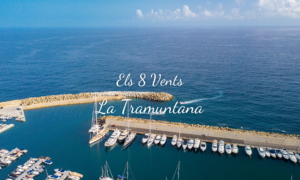Reading: 2 min
In this section, we will explore the 8 most representative winds of our region, each with its unique characteristics and impact on the environment. From the powerful northern wind to the gentler breezes, you will discover how these phenomena shape the climate, the landscape, and everyday life. We begin with the mighty Tramuntana, which transforms not only the sky and the land but also the culture.

The Tramuntana is a cold and powerful wind that blows from the north and can reach speeds of up to 200 km/h, being strongest before dawn. Its name comes from the Latin term transmontanum, meaning “beyond the mountains.” In Roman times, they referred to this wind as one coming from the other side of the mountains, pointing to northern Italy, beyond the Alps.
The Tramuntana that we feel in the Empordà originates from the north of the Pyrenees and the Central Massif of France. This wind is known for its intensity and persistence, shaping the region’s landscape and even serving as a cultural symbol. It is famous for creating clear skies and a very crisp atmosphere after it blows, but also for its effects on vegetation, which adapts to withstand its force.
According to locals, the Tramuntana paints the sky a deep blue and is believed to have a negative effect on the human psyche. It is even said that those not in their right mind are “touched by the Tramuntana”, a phrase often used to describe Salvador Dalí, who considered the wind as part of his “genius” and imagination. Or as sung by Sopa de Cabra in their song l’Empordà.
Another legend associated with the Tramuntana is that this wind is a harbinger of omens. In ancient times, people believed that when the Tramuntana blew with particular force, it meant that some significant change or unfortunate event was about to occur. This was linked to the wind’s destructive force, which could ravage crops or disrupt daily life in rural communities.
Thus, the Tramuntana is not just a meteorological phenomenon, but an element laden with superstition, mystery, and mysticism in Catalan culture.








